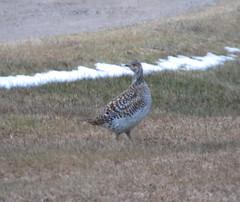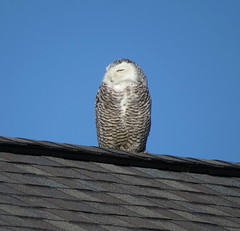Caesar Creek State Park & Spring Valley Lake
Yesterday my itinerary was to go birding at various locations in and around Caesar Creek and Spring Valley. One of the purposes was to see how high the water level was at the Northern end of the lake. When the level is low, a wide expanse of mud flats are exposed, which then makes for great viewing of migratory wading birds. With all the Spring rain we had, and how high the lake was, I’m sure the Army Corp lowered the lake level. But by how much, and to what extent I’ll soon find out.
 As you can tell by the above picture that the water level is still pretty high. Last year when I came here those bare trees out in the water on the left were sitting on mud. So you can imagine how large an area these mud flats cover. The water level being what it is now doesn’t surprise me since recreational boating is still in full swing. All sorts of water craft were criss-crossing the lake all day while I was there. It’s from this vantage point I was able to spot 3 Great Egrets and 4 very curious Prothonotary Warblers that got within 10 feet of me.
As you can tell by the above picture that the water level is still pretty high. Last year when I came here those bare trees out in the water on the left were sitting on mud. So you can imagine how large an area these mud flats cover. The water level being what it is now doesn’t surprise me since recreational boating is still in full swing. All sorts of water craft were criss-crossing the lake all day while I was there. It’s from this vantage point I was able to spot 3 Great Egrets and 4 very curious Prothonotary Warblers that got within 10 feet of me.
Since I had to drive past Spring Valley Wildlife Area to get to this particular part of the lake, I thought I’d stop by Spring Valley down where the lake is. The Loveland Bike Trail passes 100 yards from the parking lot, and it was on the part of the bike path that in the Spring myself and a couple of other birders were able to call in a Virginia Rail.
 As far as the eye could see, the lake was covered with lily pads. All the way to the tall grass and cattails that make up the marsh portion of Spring Valley in the distance.
As far as the eye could see, the lake was covered with lily pads. All the way to the tall grass and cattails that make up the marsh portion of Spring Valley in the distance.
 And all the lily pads were covered with these beautiful white flowers.
And all the lily pads were covered with these beautiful white flowers.
 After leaving Spring Valley I came across this field of Sunflowers.
After leaving Spring Valley I came across this field of Sunflowers.
Another place I wanted to return to was the nature center. I hadn’t been there since the early Spring, and because they have some very nice trails and away from the boat noise. Even though the birds weren’t plentiful, the spider webs were. It was pretty obvious that no one had walked here lately, with the dozens of webs that stretched across the trail.
After leaving the nature center I wanted to check out this old abandoned road that dead ended somewhere hopefully near the lake. Caesar Creek Lake is dotted with old roads like this before they flooded everything to create the lake. I know of several and this one is new to me. It was only one lane with dense trees and vegetation on both sides. In a couple of places along the road you can see a trail head that disappeared into the woods. And just as I thought a dead end where the lake is. However what took me by surprise was the water lillies. They were big. Probably 2 to 3 feet across, and in bloom as well.
 The view back towards the cove and if you look closely you’ll see a foot bridge for a trail that crosses the water.
The view back towards the cove and if you look closely you’ll see a foot bridge for a trail that crosses the water.
 The area where I parked was full of Tiger Swallowtail Butterflies. Here is a small group that weren’t spooked by me getting this close.
The area where I parked was full of Tiger Swallowtail Butterflies. Here is a small group that weren’t spooked by me getting this close.
Last stop for the day was the Visitors Center to see if the feeders they have there were attracting anything. I think they have the same idea as I do. We don’t feed in the Summer. There’s plenty of food for them to make it through. From the observation deck overlooking the dam, I snapped off a couple of pictures.
 If you click on the picture and make it bigger you’ll notice a larger gull with a yellow bill. That’s a Herring Gull, and the other 3 are Ring-billed Gulls. 2 adults and 1 juvenile.
If you click on the picture and make it bigger you’ll notice a larger gull with a yellow bill. That’s a Herring Gull, and the other 3 are Ring-billed Gulls. 2 adults and 1 juvenile.
Ended the day when heat and hunger took over at about 3pm. Notable birds for the day include:
- Great Egret
- Great Blue Heron
- Green Heron
- Canada Geese
- Blue-winged Teal
- Double-crested Cormorant
- Herring Gull
- Ring-billed Gull
- Killdeer
- Turkey Vulture
- Cooper’s Hawk
- American Crow
- Belted Kingfisher
- Northern Cardinal
- Blue-gray Gnatcatcher
- Mourning Dove
- American Robin
- Eastern Goldfinch
- Eastern Towhee
- Tufted Titmouse
- Carolina Chickadee
- Song Sparrow
- Field Sparrow
- Chipping Sparrow
- Downy Woodpecker
- House Wren
- Carolina Wren
- Northern Flicker
- Prothonotary Warbler
- Common Yellowthroat
- Yellow-throated warbler
- Northern Mockingbird
- Red-winged Black Bird
- Indigo Bunting
- Gray Catbird
- House Finch
- Northern Rough-winged Swallow
- Eastern Bluebird































